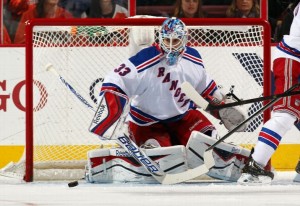The request for this post came from reader Michael Noltemeyer. Thanks for reading Michael, and feel free to submit requests for posts on specific topics or questions for a mailbag at the author addresses on the right margin.
A couple years ago, I broke down the specific goaltending styles of both Henrik Lundqvist and Marty Biron. There wasn’t really much of a need for an update to this series, since the goaltending situation remained relatively stable. Now, with the retirement of “our Marty” and the emergence of rookie backup Cam Talbot, it’s time to break down the young man’s game.
During the pre-season, I wrote a piece introducing us to the player, his background and the main features of his game. Much has changed since then, however, so let’s get into it with some more detail. The previous format will still apply: analyzing the five categories of Stance, Crease movement/depth, Equipment, Puck-handling ability and Exploitable weaknesses. Here we go…
Stance
Talbot has modified his stance considerably since turning pro. During his junior and college career, his stance was relatively compact. The basic logic is that when your core is tightly compacted, you can generate more explosive movement and rely on your quick-twitch muscles to react to shots. This type of technique is much more effective at lower levels than in the pro’s simply because the speed of shots and the game as a whole is significantly slower at those lower levels.
Since turning pro, however, Talbot has slowly expanded his stance into a more relaxed, blocking-oriented set-up. As you climb the ladder, you need to create more surface area so the margin for error increases on screen shots and deflections in order to have consistent success. By relaxing his stance a bit, Talbot is taking greater advantage of his 6’3” frame and becoming less reliant on reflexes to stop the puck.
From a visual standpoint, his stance is relatively average looking. He has a semi-wide foot set, carrying his gloves in a comfortable position, with a very balanced approach in his hips and chest.
Crease movement/depth
The stance conversation dovetails rather nicely into a breakdown of Talbot’s movement. Since getting the long-look in training camp, he has spent quite a bit of quality time with goalie coach Benoit Allaire. It’s no secret that I’m not much of a fan of his brother, Francois’ work, but Benny has been able to work wonders with the Rangers’ goaltenders. This adjustment has been the most noticeable change in Talbot’s game from his pre-season appearances.
Back when I wrote the introductory piece on Talbot in September, I noted that he had a lot of excess noise in his movement, which lead to opening up holes and affecting his balance. This has been the one area where Allaire’s work has been the most prevalent. Ranger pundits have been noting the calm demeanor that Talbot has brought since his call-up, and much of that noise has been reduced. He is moving much more fluidly and allowing the puck to come to him.
His crease depth has moved closer to the goal line (another of Allaire’s trademarks) since joining the big club, but this has allowed him to maximize the strength of his lateral game. His willingness to block more than react has lead to this previous weakness becoming a strength. Talbot has strong positional instincts and a strong butterfly slide. His overall athleticism is very solid and, as previously mentioned, has adopted a rather stoic demeanor in the net.
Equipment
Talbot is currently wearing the new Reebok Premier XLT Pro line. This line is the evolution of the P4 Pro line and has adopted many of the features from the popular CCM EFP pad, introduced last season. Since this set is not yet available to the retail public, specs are relatively sparse. However, it appears to have retained the pre-curved shape of the previous Reebok pads, with a wide leg and knee channel, while adding some of the strapping and calf-wrap features of the CCM line.
This choice in set-up for Talbot seems ideal for his newly adopted “drop and block” style. My only issue from a visual standpoint is that the design on his gloves doesn’t match those of his pads at all. There is a much heavier emphasis on the red element in the gloves than on the pads, but that’s just the goalie nerd in me.
Puck-handling ability
I haven’t gotten a chance to observe nearly enough of Talbot’s puck handling abilities to feel confident with a definitive statement. At this point though, he looks plenty competent handling the biscuit, but it doesn’t appear to be a major strength ala Marty Brodeur/Turco. He does, however, seem to be a decent upgrade on Lundqvist in this department.
Exploitable weaknesses
This category has another sample size issue. From my observations of the goals allowed so far, Talbot seems to be susceptible to screen shots low and well placed shots to the low corners. He does have good puck tracking stills through the screen, but I’m not sure how comfortable he is at this stage making himself big when he can’t see where the puck is coming from.
As Talbot gets more exposure in the Show, eventually a more in-depth scouting report will start to come into focus.
Conclusion
It will be very interesting to see how Talbot adjusts to NHL life going forward. At this point, I think his ceiling remains the same as it was back in training camp: a high-quality back-up or fringe to average starter, but goalies can always be wildcards. At least for the next couple seasons, he should be able to spell Hank competently and fill in capably in the event of an injury. As more data becomes available, I will be sure to update this post, but regardless of what the future holds, Talbot has been very impressive in his debut, and hopefully his strong play will continue into a fruitful NHL career.
Share:
More About:Analysis



